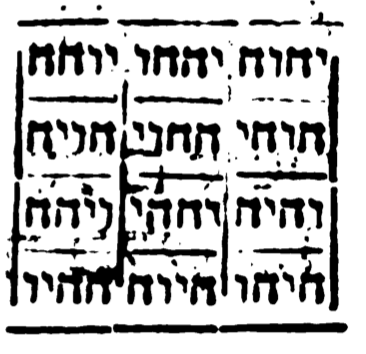Difference between revisions of "Template:Occult.live:Today's featured article"
Occultwiki (talk | contribs) |
Occultwiki (talk | contribs) |
||
| (41 intermediate revisions by the same user not shown) | |||
| Line 1: | Line 1: | ||
[[File: | [[File:YHVH Oedipus Aegyptiacus1.png|200px|left]] | ||
'''[[ | The '''[[Tetragrammaton]]''' is the four-letter Hebrew theonym יהוה (transliterated as YHWH), the name of [[Yahweh|God]] in the Hebrew [[Bible]]. The four letters, written and read from right to left (in Hebrew), are yodh, he, waw, and he. The name may be derived from a verb that means "to be," "to exist," "to cause to become," or "to come to pass." While there is no consensus about the structure and etymology of the name, the form Yahweh is now accepted almost universally, though the vocalization Jehovah continues to have wide usage. | ||
The books of the Torah and the rest of the Hebrew Bible except Esther, Ecclesiastes, and (with a possible instance of the short form יה in verse 8:6) the Song of Songs contain this Hebrew name. Observant Jews and those who follow Talmudic [[Judaism|Jewish]] traditions do not pronounce יהוה nor do they read aloud proposed transcription forms such as Yahweh or Yehovah. | |||
'''([[ | '''([[Tetragrammaton|Full Article...]])''' | ||
Latest revision as of 16:37, 17 October 2025
The Tetragrammaton is the four-letter Hebrew theonym יהוה (transliterated as YHWH), the name of God in the Hebrew Bible. The four letters, written and read from right to left (in Hebrew), are yodh, he, waw, and he. The name may be derived from a verb that means "to be," "to exist," "to cause to become," or "to come to pass." While there is no consensus about the structure and etymology of the name, the form Yahweh is now accepted almost universally, though the vocalization Jehovah continues to have wide usage.
The books of the Torah and the rest of the Hebrew Bible except Esther, Ecclesiastes, and (with a possible instance of the short form יה in verse 8:6) the Song of Songs contain this Hebrew name. Observant Jews and those who follow Talmudic Jewish traditions do not pronounce יהוה nor do they read aloud proposed transcription forms such as Yahweh or Yehovah.
